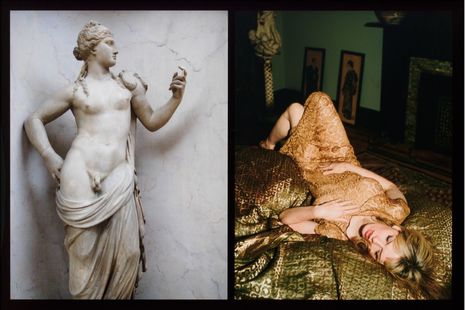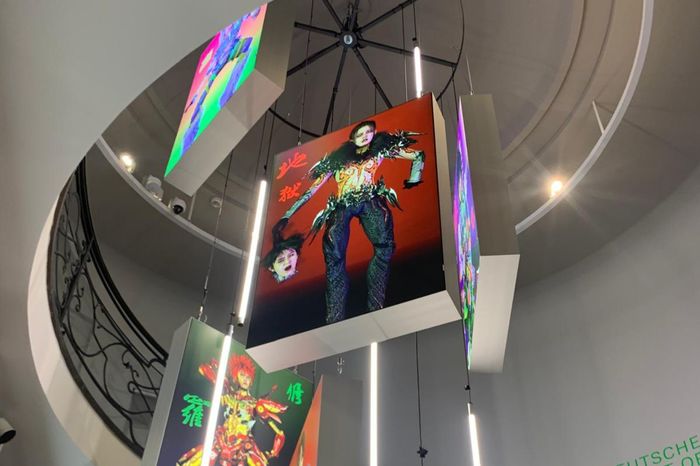‘My pictures show me how much I’ve lost’: Nan Goldin’s photographs as memorials
Madeleine Whitmore explores the lasting potency of Goldin’s emotive documentation of New York’s queer subcultures in the 1980s

At the end of my first year of Sixth Form I assembled an installation piece in the corner of my school’s art studio, ready for their annual show. It was a bit bizarre: I hung a circle of copper wire from the ceiling, and from that hung tiny drawings of faces and figures; some were those of my family and friends and some were ones I’d lifted from photographs by Nan Goldin. My art teachers left me to it, coming over every so often to squint confusedly at the tangled bodies and kissing faces.
The photographs I worked from were from The Ballad of Sexual Dependency, a series of images taken between 1979 and 1986, documenting New York’s queer subculture of the time, as well as Goldin’s family, lovers and friends. I was hooked on them: they were an aesthetic, albeit diluted, version of the heroin she photographed her peers injecting, and the sex she captured them having. For my eighteenth birthday, my mum bought me a book of the photographs. It’s one of the most precious things I own.
“A thread of uniquely temporal panic runs through all art of this period”
In the preface for her monograph I’ll Be Your Mirror, Goldin declares the following: “I used to think I could never lose anyone if I photographed them enough. In fact, my pictures show me how much I’ve lost.” A blistering line in any context, this sentiment is particularly devastating given the circumstances surrounding many of Goldin’s friends’ deaths — as well as documenting the beauty and visceral expression of urban queer art and sexual culture. The Ballad of Sexual Dependency in particular documents the AIDs years. Many of Goldin’s close friends, including writer Cookie Mueller and artist David Wojnarowicz, had diagnoses that eventually proved fatal.
As I research the epidemic, and wealth of art and writing that came out of the period for my dissertation, I am finding that a thread of uniquely temporal panic runs through every essay, journal, play, and novel a sense that an HIV diagnosis at this time was a catalyst for the sufferer’s uncontrollable journey towards pain, blackness, and an erosion of the most basic of dignities. And so it’s not surprising that Goldin’s work was, for her, primarily a way of immortalising those moments and people she adored. She hails from a particular school of art uniquely concerned with and aware of the possibilities for loss, as well as for memorialisation.
“Goldin’s photographs are unpolished, bodily and deeply provocative”
A friend took me to visit Elton John’s photography collection at the V&A last week. She’d told me that she thought there might be one or two Goldin photographs included, but what I wasn’t expecting was to turn a corner and enter an entire room plastered from floor to ceiling with her work. I lost my breath for a moment, which sounds pretentious to a sort of unbelievable degree, but as someone who has attended their fair share of shocking open mics I know how to distinguish between real and affected emotion. I promise this was real.
Goldin’s photographs are unpolished, bodily and deeply provocative. Some are sexy, but not titillating or pornographic; their allure comes not from a capturing of explicit sexual activity but from their composition, the expressions and intricacies of her subject’s faces and positions. Others are sharp, bloody; one titled Ectopic pregnancy scar, New York City depicts the midriff and vulva of its subject, the two body parts divided by a fresh red scar dotted with painful looking sutures. Heart-shaped bruise is similarly brutal and tender, the subject’s skirt pulled up to reveal on her thigh just what the title suggests.
“Her work is earnest. Not much art is earnest any more”
I don’t have a favourite of Goldin’s photographs. That would be like trying to pick a favourite body part. But there are three I’ve been thinking about a lot. One is a cibachrome print titled Cookie and Vittorio’s wedding, New York City [1986]. In the V&A it’s displayed just a foot or so from another print, Cookie at Vittorio’s casket, NYC, September 16, 1989. The third of this morbid triptych is Cookie in her casket, NYC, November 15, 1989. You can piece together the narrative yourself. Both lovers passed from AIDs-related complications. Cookie, always depicted as bright and effervescent in life, glows even in death, the velvet of her casket lit strangely by the light reflected off a cross placed on her chest. In her wedding photograph she is crying, wiping her eye as Vittorio smiles next to her.
The unique, gritty temporality and emotional exposition at play in Goldin’s work make her images ubiquitously relevant; they are brutally honest and intense in a way a lot of contemporary photography is struggling towards. They are earnest. Not much art is earnest any more. The three images discussed above, placed adjacently, are indicative of what exactly drew me to Goldin’s work in the first place, and of what I continue to gravitate towards as I try to weave together, and chart my own life and emotion through photography and writing: the sense that there is never enough time. But, to stop creating and loving for this reason would be as absurd as to stop breathing because you can’t hold the air in your lungs forever.
 Comment / Cambridge students are too opinionated 21 April 2025
Comment / Cambridge students are too opinionated 21 April 2025 Interviews / Meet the Chaplain who’s working to make Cambridge a university of sanctuary for refugees20 April 2025
Interviews / Meet the Chaplain who’s working to make Cambridge a university of sanctuary for refugees20 April 2025 News / News in brief: campaigning and drinking20 April 2025
News / News in brief: campaigning and drinking20 April 2025 Comment / Cambridge’s tourism risks commodifying students18 April 2025
Comment / Cambridge’s tourism risks commodifying students18 April 2025 Comment / Cambridge’s gossip culture is a double-edged sword7 April 2025
Comment / Cambridge’s gossip culture is a double-edged sword7 April 2025






